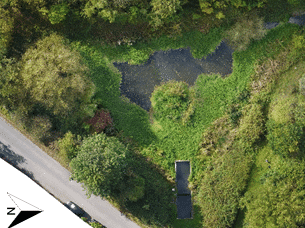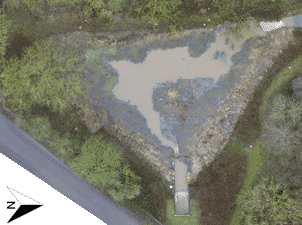
Effects of Seasonal Variation of Vegetation on Hydraulic Residence Time Distributions in a Stormwater Pond
2Departamento de Ingeniería Civil y Ambiental, Universidad Autónoma de Ciudad Juárez
3Department of Civil and Structural Engineering, University of Sheffield
Vegetated water treatment systems follow a natural growth cycle on an annual basis. Vegetation grows through the spring and summer and then dies back over the winter. From aerial imagery, it is clear to observe the difference in vegetation extent between summer and winter.
 |
 |
| Summer Vegetation Distribution | Winter Vegetation Distribution |
Treatment system performance is often evaluated using residence time distributions (RTDs). RTDs will be different for different discharges. However, when normalised for discharge, the shape of the RTDs for the same system should be similar. The change in vegetation coverage throughout the year alters the system’s bathymetry summer vegetation has a greater resistance than winter vegetation/free water. As such, it is likely that the system RTD will change from summer to winter, which would have an impact on system design and treatment performance.
Fluorescent dye traces were conducted at a stormwater pond field site in Warwickshire, UK, in both summer and winter to evaluate the system RTD. The bathymetry of the site was surveyed and the vegetation distribution was analysed using aerial imagery in summer and winter.
The results of the study showed that the change in vegetation had a significant impact on system hydraulics. The total vegetation coverage varied between 61% in summer to 38% in winter. In terms of the RTDs, first arrival times and peak concentration times were similar for both summer and winter. However, the winter data showed less spread, and had a lower mean residence time than the summer data. The data suggests that the summer flow experienced more mixing, probably due to the vegetation.
The fact that the winter residence times were lower is in some ways surprising. Despite a lower vegetation coverage, it is clear that the bulk of the flow travelled through a short-circuiting route and did not experience the full volume. This may be due to the design of this pond: in summer, a large patch of vegetation emerges from the northern bank, blocking the shortest route between inlet and outlet; in winter, this vegetation dies back and this more direct flow path is opened up. It is expected that for other systems seasonal changes in vegetation would impact on the system RTD. The vegetation type, spatial distribution and seasonal variations need to be considered when assessing the residence time distributions for stormwater ponds.


Powered by Eventact EMS